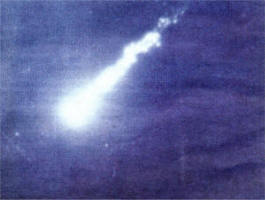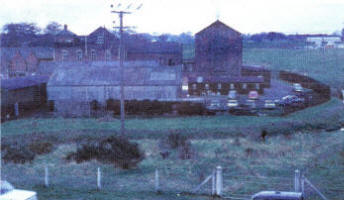
Sprucefield meteorite that 4.5 billion years in the making
Remarkable story is recounted 40 years
on by JULIE-ANN SPENCE
 |
 |
| The fireball photographed by a schoolboy, Hugh Malcolm Walker, as it passed over north Wales and Sprucefield in 1969. | |
ALMOST exactly 40 years ago a brilliant fireball streaked across the night sky, leaving behind two rocks, a damaged roof, and a hole in a field.
It caused a sensation in Northern Ireland at the time, but the story of what happened to them before they arrived here will be told in a fascinating talk in Lisburn next week.
Dr Mike Simms, from the Ulster Museum, will take you on a journey from the very beginnings of the Solar System, as recorded in these amazing meteorites, one of which landed at Sprucefield in 1969, during his presentation at Lisburn Museum on Thursday April 30 at 7pm.
It was the evening of Friday April 25, 1969, when people across Northern Ireland were startled by a series of loud bangs. Those outside witnessed a once-in-a-lifetime event that caused these sonic booms - the fall of a spectacular meteor. It entered Earth's atmosphere travelling at more than 35,000 mph and heating the air around it to more than 4000°C and began to break up.
Over the next few days two meteorites - fragments from this fireball - were found. The larger, weighing nearly 9Ib (4.95kg) had landed in a field at Bovedy, near Garvagh.
The smaller weighed only a little over a pound (513g) but had smashed through the roof of an RUC store at Sprucefield to land on a desk, where it was found on the following Monday morning.
Spectacular though these events were, they were just the final episode in the story of these meteorites, which are the last to have been found in Northern Ireland.
To celebrate the 40th anniversary of their arrival Dr Simms, an expert on meteorites, will be giving an illustrated talk about these amazing visitors from outer space.
There will be a chance to see, and handle, some real meteorites, and a cast of the Bovedy meteorite (the real one is on display at Armagh Planetarium). You can also bring along any meteorites you think you might have found. The talk at Lisburn Museum is free of charge. For further information contact the museum on 9266 3377.
Ulster Star
24/04/2009
